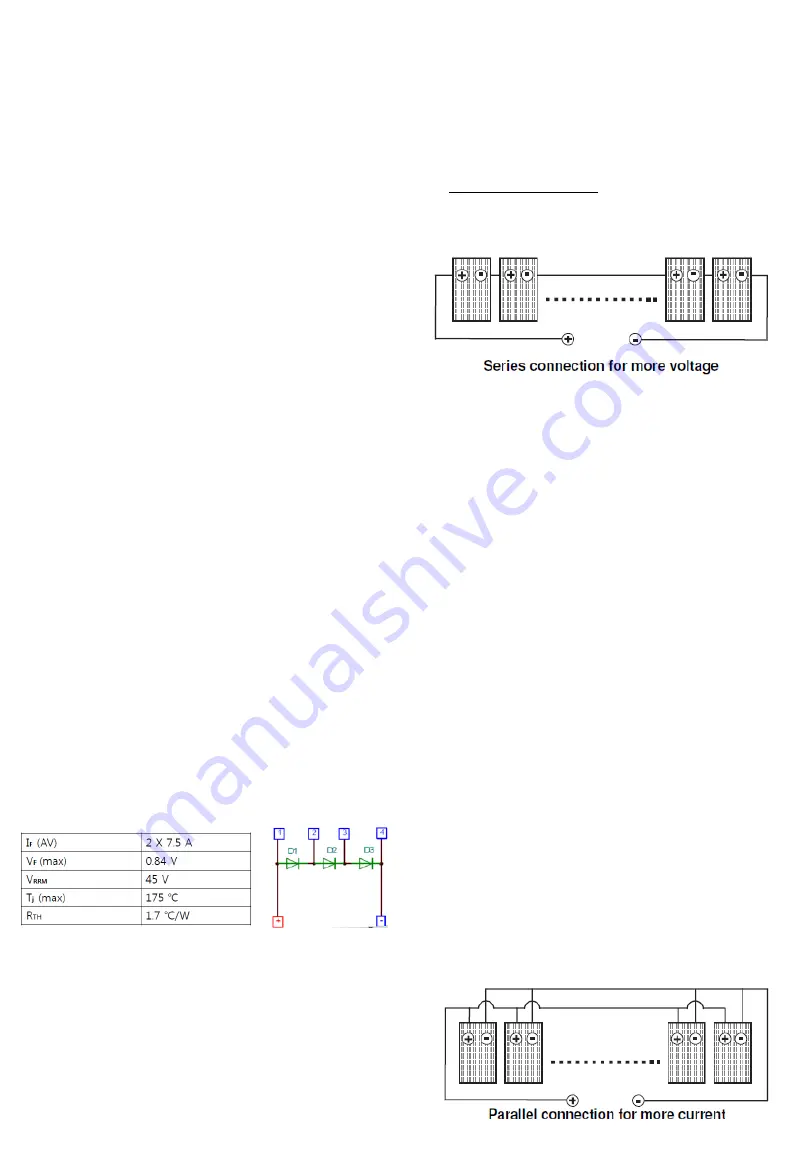
Electrical Installation
Danger
• Avoid all electrical hazards when installing, wiring,
operating and maintaining all panels.
• Do not connect panels that have different electrical
properties or physical configurations in the same
system.
• Match the polarities of cables and terminals when
making the connections; failure to do so may result in
damage to the panel.
• The rating of the over-current device shall not exceed
the maximum series fuse rating marked on the name
plate.
• The panel contains factory installed bypass diodes
located inside the junction box.
• When installing the system, it is recommended to
install a lightning rod to protect the system.
• The junction box should not be opened. Opening the
junction box will void the warranty.
• Panels with a suspected electrical problem should be
returned to LG Electronics for inspection and possible
repair or replacement per the limited warranty provided
by LG Electronics
Electrical Connections
• Shock hazard may occur near the solar modules
electrical connections.
• Modules may be connected in series and/or parallel to
achieve the desired electrical output as long as it is
within the guidelines on the product specification sheet.
• Please use only the same type of modules in a
combined source circuit.
• Do not disconnect the module when it is operating.
Shock hazard may occur near the solar modules
connection means.
Diodes
• All LG modules are equipped with factory installed
bypass diodes. The factory-installed diodes provide
proper circuit protection for the systems within the
specified system voltage.
Series Connection
• The solar modules may be wired in series to produce
the desired voltage output.
• The current of each module connected in series should
be the same.
• The maximum number of series connected
modules can be determined by max system voltage,
the
125%
safety
factor
not
explained
in
specifications, and the module Voc which can be
checked in
“Product Specifications” in this
document.
Do not exceed 80%
of maximum system voltage.
• Maximum Module configuration (recommend): refer
to the
„Product Specification‟ in this manual.
Parallel Connection
• The solar modules may be combined in parallel to
produce the desired current output.
• When modules are combined in parallel, the total
current is equal to the sum of currents from each
module.
• The voltage of each module connected in parallel
should be the same.
• When connecting plural strings of modules in parallel
every series string or solar module must be fused prior
to combining with other strings.
• Abide with all applicable federal, state, and local codes
for additional fusing requirements and limitations on the
maximum number of solar modules in parallel.
• Maximum parallel strings without proper measures, e.
g. fuse 15 A and/or blocking diode: 1 string.
• Parallel configuration is not limited if proper measures
are taken to block the reverse current flow, e.g. fuses for
the protection of the module and cables from over-
current and/or blocking diodes for prevention of
unbalanced string voltage.
• A multiplying factor is required for increased output of
the PV modules. Under normal conditions, a PV module
is likely to experience conditions that produce more
current and/or voltage than reported at standard test
conditions. Accordingly, the values of Isc and Voc
marked on this PV module should be multiplied by a
factor of 125% when determining component voltage
ratings, conductor ampacities, fuse sizes, and size of
controls to the PV output.
• Follow all national, state and local codes and
standards applicable to overcurrent protection.
4
Diode specification and configuration





























